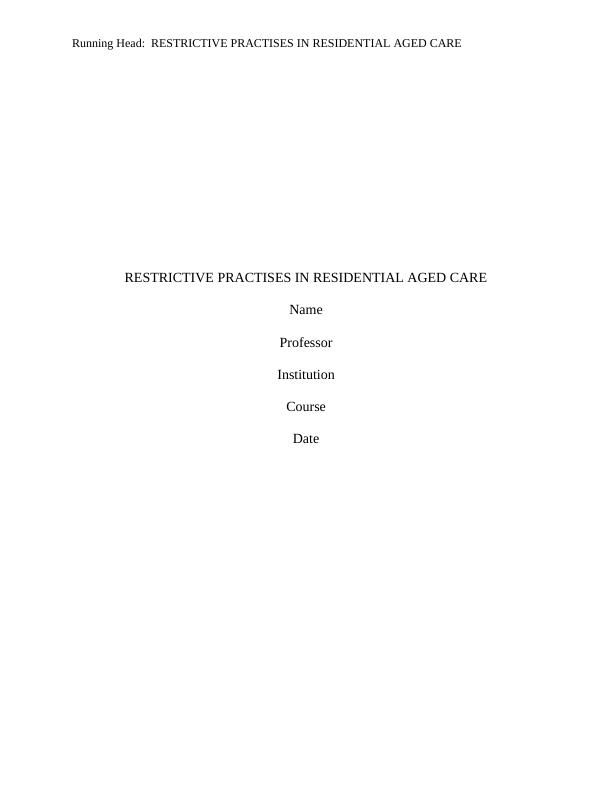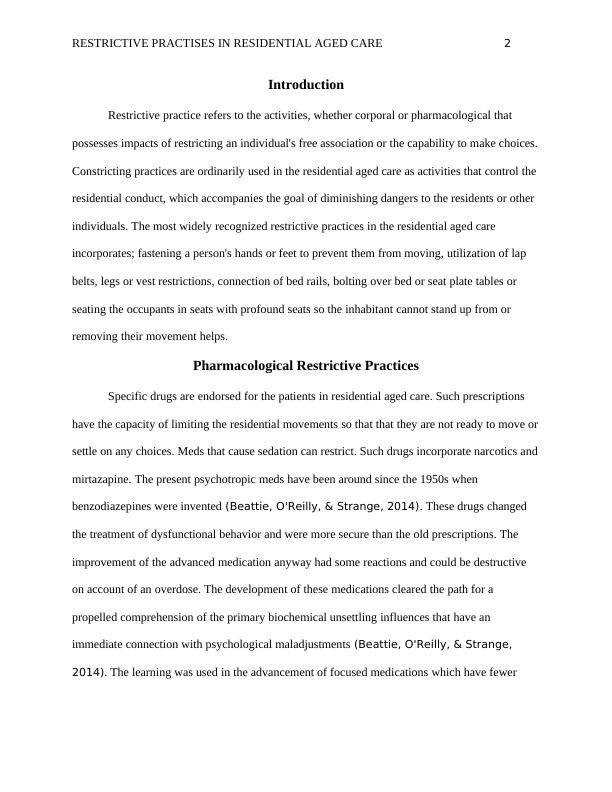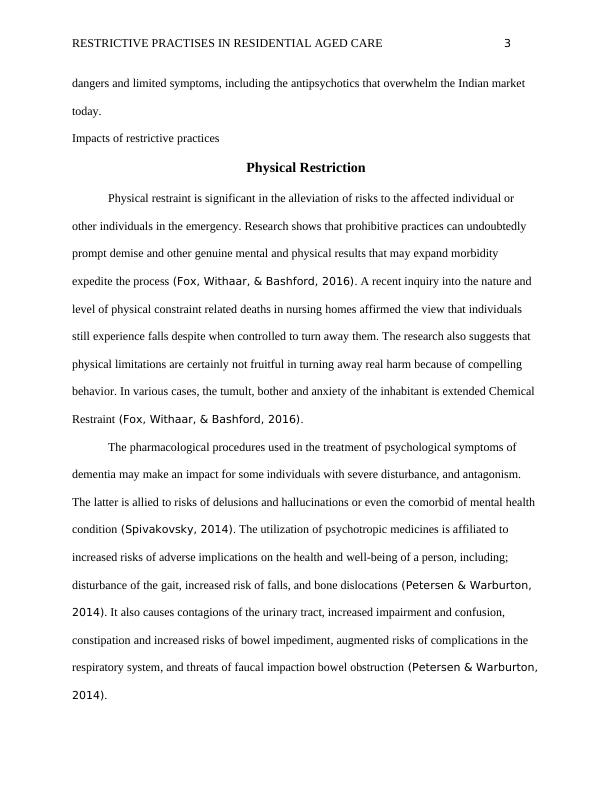Restrictive Practices in Residential Aged Care
Added on 2022-12-29
10 Pages2461 Words89 Views
Running Head: RESTRICTIVE PRACTISES IN RESIDENTIAL AGED CARE
RESTRICTIVE PRACTISES IN RESIDENTIAL AGED CARE
Name
Professor
Institution
Course
Date
RESTRICTIVE PRACTISES IN RESIDENTIAL AGED CARE
Name
Professor
Institution
Course
Date

RESTRICTIVE PRACTISES IN RESIDENTIAL AGED CARE 2
Introduction
Restrictive practice refers to the activities, whether corporal or pharmacological that
possesses impacts of restricting an individual's free association or the capability to make choices.
Constricting practices are ordinarily used in the residential aged care as activities that control the
residential conduct, which accompanies the goal of diminishing dangers to the residents or other
individuals. The most widely recognized restrictive practices in the residential aged care
incorporates; fastening a person's hands or feet to prevent them from moving, utilization of lap
belts, legs or vest restrictions, connection of bed rails, bolting over bed or seat plate tables or
seating the occupants in seats with profound seats so the inhabitant cannot stand up from or
removing their movement helps.
Pharmacological Restrictive Practices
Specific drugs are endorsed for the patients in residential aged care. Such prescriptions
have the capacity of limiting the residential movements so that that they are not ready to move or
settle on any choices. Meds that cause sedation can restrict. Such drugs incorporate narcotics and
mirtazapine. The present psychotropic meds have been around since the 1950s when
benzodiazepines were invented (Beattie, O'Reilly, & Strange, 2014). These drugs changed
the treatment of dysfunctional behavior and were more secure than the old prescriptions. The
improvement of the advanced medication anyway had some reactions and could be destructive
on account of an overdose. The development of these medications cleared the path for a
propelled comprehension of the primary biochemical unsettling influences that have an
immediate connection with psychological maladjustments (Beattie, O'Reilly, & Strange,
2014). The learning was used in the advancement of focused medications which have fewer
Introduction
Restrictive practice refers to the activities, whether corporal or pharmacological that
possesses impacts of restricting an individual's free association or the capability to make choices.
Constricting practices are ordinarily used in the residential aged care as activities that control the
residential conduct, which accompanies the goal of diminishing dangers to the residents or other
individuals. The most widely recognized restrictive practices in the residential aged care
incorporates; fastening a person's hands or feet to prevent them from moving, utilization of lap
belts, legs or vest restrictions, connection of bed rails, bolting over bed or seat plate tables or
seating the occupants in seats with profound seats so the inhabitant cannot stand up from or
removing their movement helps.
Pharmacological Restrictive Practices
Specific drugs are endorsed for the patients in residential aged care. Such prescriptions
have the capacity of limiting the residential movements so that that they are not ready to move or
settle on any choices. Meds that cause sedation can restrict. Such drugs incorporate narcotics and
mirtazapine. The present psychotropic meds have been around since the 1950s when
benzodiazepines were invented (Beattie, O'Reilly, & Strange, 2014). These drugs changed
the treatment of dysfunctional behavior and were more secure than the old prescriptions. The
improvement of the advanced medication anyway had some reactions and could be destructive
on account of an overdose. The development of these medications cleared the path for a
propelled comprehension of the primary biochemical unsettling influences that have an
immediate connection with psychological maladjustments (Beattie, O'Reilly, & Strange,
2014). The learning was used in the advancement of focused medications which have fewer

RESTRICTIVE PRACTISES IN RESIDENTIAL AGED CARE 3
dangers and limited symptoms, including the antipsychotics that overwhelm the Indian market
today.
Impacts of restrictive practices
Physical Restriction
Physical restraint is significant in the alleviation of risks to the affected individual or
other individuals in the emergency. Research shows that prohibitive practices can undoubtedly
prompt demise and other genuine mental and physical results that may expand morbidity
expedite the process (Fox, Withaar, & Bashford, 2016). A recent inquiry into the nature and
level of physical constraint related deaths in nursing homes affirmed the view that individuals
still experience falls despite when controlled to turn away them. The research also suggests that
physical limitations are certainly not fruitful in turning away real harm because of compelling
behavior. In various cases, the tumult, bother and anxiety of the inhabitant is extended Chemical
Restraint (Fox, Withaar, & Bashford, 2016).
The pharmacological procedures used in the treatment of psychological symptoms of
dementia may make an impact for some individuals with severe disturbance, and antagonism.
The latter is allied to risks of delusions and hallucinations or even the comorbid of mental health
condition (Spivakovsky, 2014). The utilization of psychotropic medicines is affiliated to
increased risks of adverse implications on the health and well-being of a person, including;
disturbance of the gait, increased risk of falls, and bone dislocations (Petersen & Warburton,
2014). It also causes contagions of the urinary tract, increased impairment and confusion,
constipation and increased risks of bowel impediment, augmented risks of complications in the
respiratory system, and threats of faucal impaction bowel obstruction (Petersen & Warburton,
2014).
dangers and limited symptoms, including the antipsychotics that overwhelm the Indian market
today.
Impacts of restrictive practices
Physical Restriction
Physical restraint is significant in the alleviation of risks to the affected individual or
other individuals in the emergency. Research shows that prohibitive practices can undoubtedly
prompt demise and other genuine mental and physical results that may expand morbidity
expedite the process (Fox, Withaar, & Bashford, 2016). A recent inquiry into the nature and
level of physical constraint related deaths in nursing homes affirmed the view that individuals
still experience falls despite when controlled to turn away them. The research also suggests that
physical limitations are certainly not fruitful in turning away real harm because of compelling
behavior. In various cases, the tumult, bother and anxiety of the inhabitant is extended Chemical
Restraint (Fox, Withaar, & Bashford, 2016).
The pharmacological procedures used in the treatment of psychological symptoms of
dementia may make an impact for some individuals with severe disturbance, and antagonism.
The latter is allied to risks of delusions and hallucinations or even the comorbid of mental health
condition (Spivakovsky, 2014). The utilization of psychotropic medicines is affiliated to
increased risks of adverse implications on the health and well-being of a person, including;
disturbance of the gait, increased risk of falls, and bone dislocations (Petersen & Warburton,
2014). It also causes contagions of the urinary tract, increased impairment and confusion,
constipation and increased risks of bowel impediment, augmented risks of complications in the
respiratory system, and threats of faucal impaction bowel obstruction (Petersen & Warburton,
2014).

End of preview
Want to access all the pages? Upload your documents or become a member.
